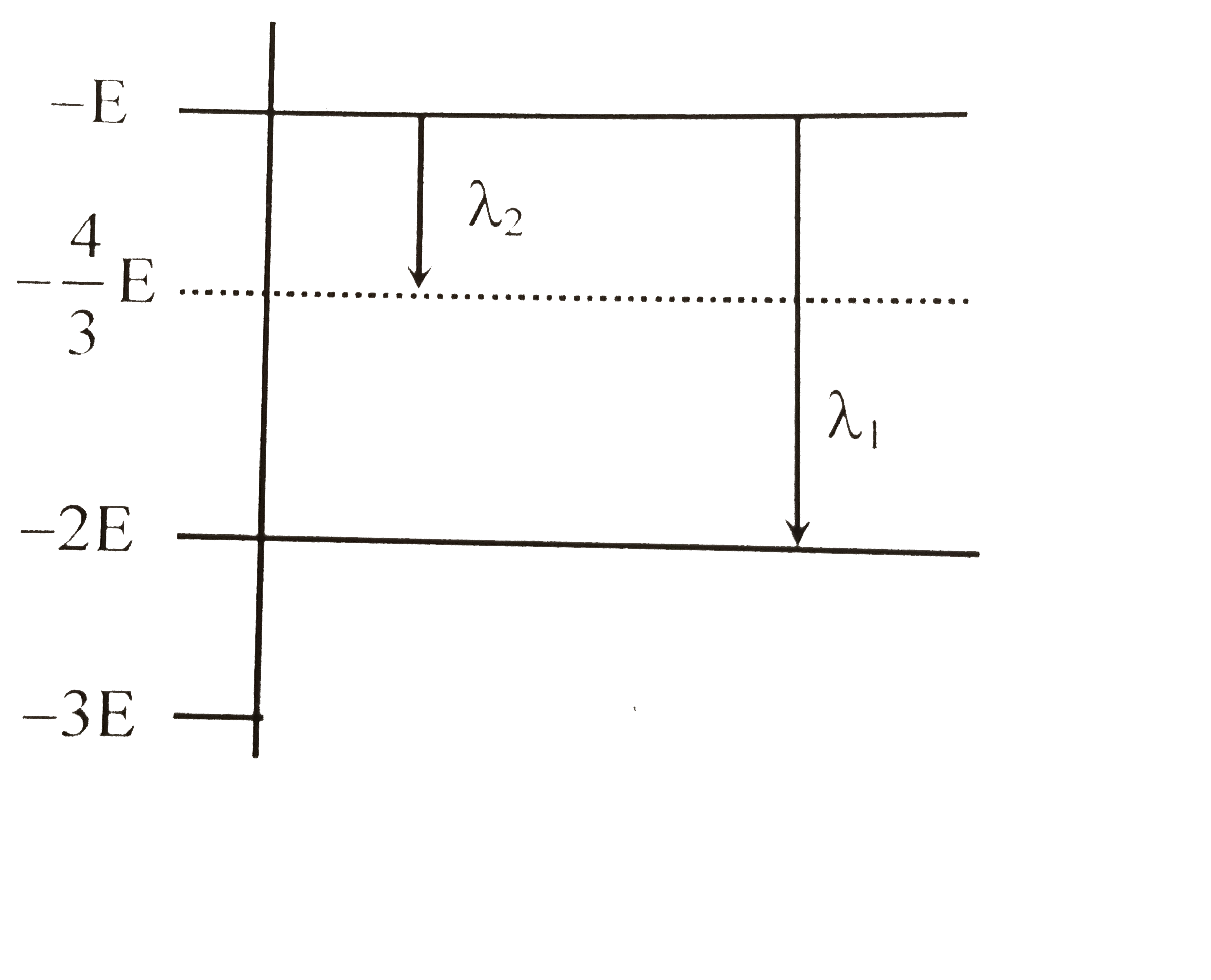V1 and V2 are the stopping potentials for the incident radiations of wave lengths λ1 and λ2 respectively are incident on a metallic surface. If λ1=3λ2 then
V1>3V2
V2>3V1
V1>V23
V1<V23
The correct Answer is:D
To solve the problem step by step, we will use the concepts of stopping potential and the photoelectric effect.
1. Understanding the Stopping Potential:
The stopping potential V for a photon of wavelength λ incident on a metallic surface is given by the equation:
eV=hcλ−ϕ
where e is the charge of the electron, h is Planck's constant, c is the speed of light, and ϕ is the work function of the metal.
2. Setting Up the Equations:
For the two wavelengths λ1 and λ2, we can write two equations for the stopping potentials V1 and V2:
eV1=hcλ1−ϕ(1)
eV2=hcλ2−ϕ(2)
3. Substituting the Given Condition:
We are given that λ1=3λ2. We can substitute this into equation (1):
eV1=hc3λ2−ϕ
4. Rearranging the Equations:
Now we can express both equations in terms of V1 and V2:
- From equation (1):
eV1=hc3λ2−ϕ
- From equation (2):
eV2=hcλ2−ϕ
5. Eliminating the Work Function:
We can eliminate ϕ by subtracting equation (2) from equation (1):
eV1−eV2=(hc3λ2−ϕ)−(hcλ2−ϕ)
Simplifying this gives:
e(V1−V2)=hc3λ2−hcλ2
e(V1−V2)=hc3λ2−3hc3λ2=−2hc3λ2
6. Finding the Relation Between V1 and V2:
Dividing both sides by e:
V1−V2=−2hc3eλ2
Rearranging gives:
V1=V2−2hc3eλ2
7. Analyzing the Result:
Since 2hc3eλ2 is a positive quantity, we can conclude:
V1<V2
Thus, we can say that V1 is less than V2 by a certain amount.
Final Answer:
The stopping potential V1 is less than V2 by a factor related to the wavelengths, specifically:
V1<V2−2hc3eλ2
The stopping potential V for a photon of wavelength λ incident on a metallic surface is given by the equation:
eV=hcλ−ϕ
where e is the charge of the electron, h is Planck's constant, c is the speed of light, and ϕ is the work function of the metal.
For the two wavelengths λ1 and λ2, we can write two equations for the stopping potentials V1 and V2:
eV1=hcλ1−ϕ(1)
eV2=hcλ2−ϕ(2)
We are given that λ1=3λ2. We can substitute this into equation (1):
eV1=hc3λ2−ϕ
Now we can express both equations in terms of V1 and V2:
- From equation (1):
eV1=hc3λ2−ϕ
- From equation (2):
eV2=hcλ2−ϕ
We can eliminate ϕ by subtracting equation (2) from equation (1):
eV1−eV2=(hc3λ2−ϕ)−(hcλ2−ϕ)
Simplifying this gives:
e(V1−V2)=hc3λ2−hcλ2
e(V1−V2)=hc3λ2−3hc3λ2=−2hc3λ2
Dividing both sides by e:
V1−V2=−2hc3eλ2
Rearranging gives:
V1=V2−2hc3eλ2
Since 2hc3eλ2 is a positive quantity, we can conclude:
V1<V2
Thus, we can say that V1 is less than V2 by a certain amount.
The stopping potential V1 is less than V2 by a factor related to the wavelengths, specifically:
V1<V2−2hc3eλ2
Topper's Solved these Questions
- DUAL NATURE OF RADIATION AND MATTERBook:AAKASH SERIESChapter:DUAL NATURE OF RADIATION AND MATTERExercise:EXERCISE=II
Explore 42 Videos
- CURRENT ELECTRICITYBook:AAKASH SERIESChapter:CURRENT ELECTRICITYExercise:EXERCISE - IA
Explore 2 Videos
- ELECTRIC CHARGES AND FIELDSBook:AAKASH SERIESChapter:ELECTRIC CHARGES AND FIELDSExercise:Practice Exercise
Explore 57 Videos
Similar Questions
Photoelectrons ar ejected from a surface when light of wavelenght λ1=550nm is incident on it. The stopping potential for such electrons is λS1=0.19V. Suppose that radiation of wavelength λ2=190nm is incident of the surface.
Q. Calculate the stopping potential VS2.
View SolutionThe ration of resolving powers of an optical microscope for two wavelangths
λ1=4000 Åandλ2=6000Åis
View SolutionPhotoelectrons ar ejected from a surface when light of wavelenght λ1=550nm is incident on it. The stopping potential for such electrons is λS1=0.19V. Suppose that radiation of wavelength λ2=190nm is incident of the surface.
Q. Calulate the work function of the surface.
View SolutionWhat amount of energy sould be added to an electron to reduce its de Broglie wavelength λ1=550nm incident on it, causing the ejection of photoelectrons for which the stopping potential is Vs1=0.19V. If the radiation of wavelength λ2=190nm is now incident on the surface, (a) calculate the stopping potential VS2, (b) the work function of the surface, and (c) the threshold frequency for the surface.
View Solution
Some energy levels of a molecule are shown in the figure. The ratio of the wavelength r=λ1λ2,is given by:
View SolutionIn a photoelectric effect measurement, the stopping potential for a given metal is found to be V0 volt, when radiation of wavelength λ0 is used. If radiation of wavelength 2λ0 is used with the same metal, then the stopping potential (in V) will be
View SolutionLi2+ is initially is ground state. When radiation of wavelength λ0 incident on it, it emits 6 different wavelengths during de excitation find λ0
View SolutionLi2+ is initially is ground state. When radiation of wavelength λ0 incident on it, it emits 6 different wavelengths during de excitation find λ0
View SolutionWhen a centimeter thick surface is illuminated with light of wavelength λ, the stopping potential is V. When the same surface is illuminated by light of wavelength 2λ, the stopping potential is V3. Threshold wavelength for the metallic surface is
View SolutionElectron are accelerated through a potential difference V and protons are accelerated through a potential difference of 4 V. The de-Broglie wavelength are λeandλp for electrons and protons, respectively The ratio of λeλp is given by ( given , me is mass of electron and mp is mass of proton )
View Solution

